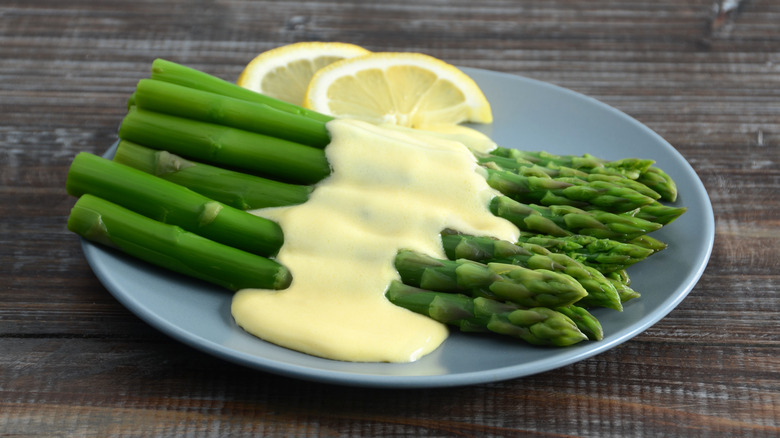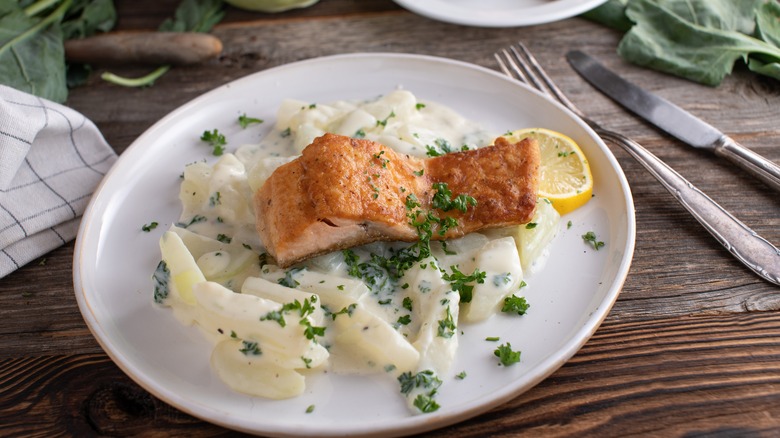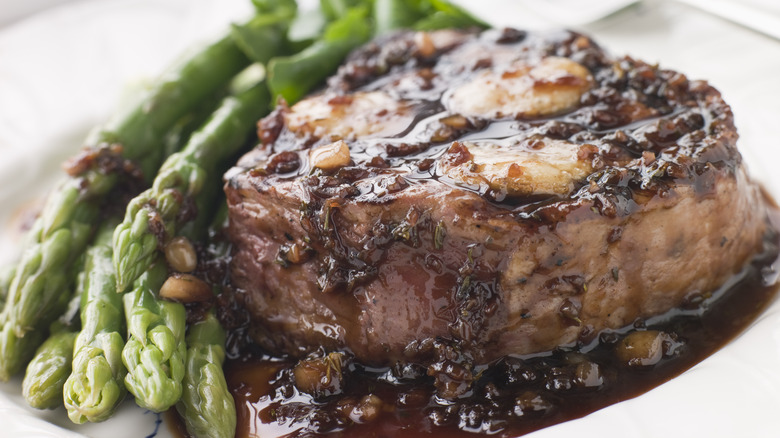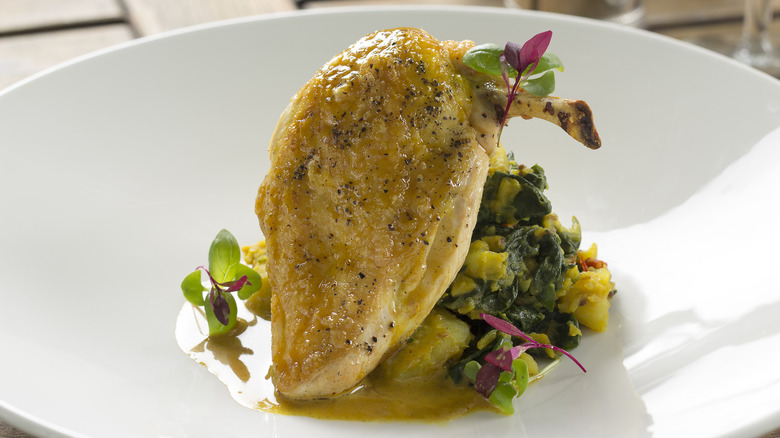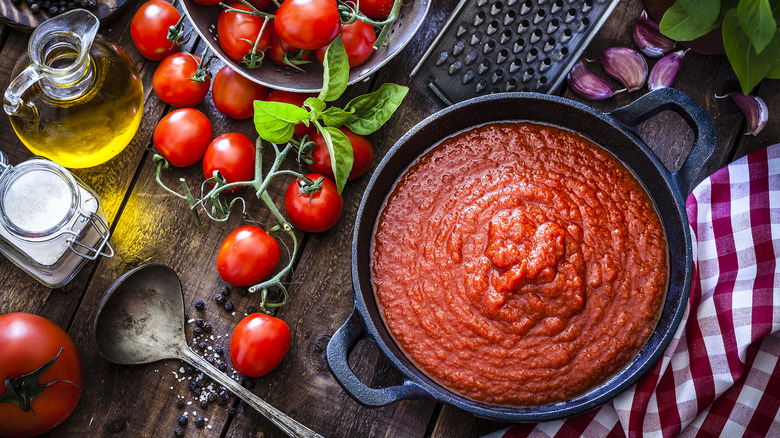How To Make And Use The French Mother Sauces
If you are a fan of French cuisine, you probably know that the French are experts in sauce making. From common ones such as hollandaise to obscure ones such as Nantua sauce, these flavor bombs form the backbone of haute cuisine and are widely used in kitchens everywhere. These sauces are the bases for many dishes you may not expect, including things like mac and cheese and country gravy.
But did you know there is a hierarchy to these sauces? First categorized by chef Marie Antoine Carême in 1833, it was organized and listed by Auguste Escoffier, one of the greatest French chefs who revolutionized the way professional kitchen works, in his book "Le Guide Culinaire." Today, chefs generally acknowledge his list of five sauces as the "mother sauces" of French cuisine: hollandaise, béchamel, velouté, Espagnole, and tomato. These sauces are considered "mothers" because they serve as the starting point from which countless other sauces can be derived by adding additional ingredients or altering the flavors and seasonings.
Hollandaise sauce
A tangy egg-based sauce, you have most likely encountered hollandaise poured over your eggs benedict or a plate of asparagus. It is made by emulsifying clarified butter with eggs, which acts as a thickener in this case. It is flavored with lemon juice, salt, and pepper. Since butter contains water and milk solids, it is necessary to clarify it before mixing it with eggs — otherwise, it will not emulsify properly.
As a mother sauce, hollandaise forms the basis of other "daughter" sauces, made by adding additional flavorings to the base recipe. For example, add tarragon and chervil to hollandaise, and it becomes béarnaise, a popular sauce for grilled steaks. When whipped cream is folded into hollandaise, it becomes a mousseline sauce, a fluffier and lighter derivative.
Sometimes, the daughter sauces themselves become the "mother" of other sauces. In the case of béarnaise, it can transform into a seasoned foyot sauce — a hollandaise with fresh herbs, meat glaze, and shallots — by adding demi-glace (which itself is a daughter sauce), or a Charon sauce by adding tomato puree.
Béchamel sauce
If you have ever made a proper mac and cheese from scratch, you have used a béchamel sauce. It is a milk-based sauce that is thickened by a roux, which in turn is made by cooking equal parts of flour and butter in a pan until it takes on the desired color. In this case, the roux will be very lightly colored as the bechamel is white. The sauce is flavored with onion, cloves, and nutmeg, and it is a common sauce to use in casserole-type dishes such as the aforementioned mac and cheese, lasagna, and scalloped potatoes among many others.
The mild flavor of béchamel makes it the base for many daughter sauces, some as ubiquitous as béchamel itself. Adding heavy cream, grated parmesan cheese, and egg yolks and you will get a cheesy mornay sauce — while adding pureed sauteed onions makes soubise sauce, commonly called a "French onion sauce". And adding shellfish stock and butter to béchamel creates Nantua sauce, which is commonly eaten with fish and seafood.
Espagnole sauce
Espagnole sauce, also known as brown sauce, is a rich and deeply flavorful sauce based on brown stock, thickened by brown roux (roux that was cooked longer until browned), and flavored by the stock, sauteed mirepoix (a mixture of onions, carrots, and celery) and tomato paste. The sauce is simmered and reduced to develop its distinctive taste and velvety texture.
Several "daughter sauces" are created with Espagnole as their base. They include demi-glace, which is made by reducing espagnole sauce and brown stock to intensify its flavor.
The delicious bordelaise sauce is created by combining espagnole sauce with red wine, marrow, shallots, and herbs, resulting in a delicious sauce perfect for steak or roasted meats. Chicken dishes can be enhanced with a chasseur sauce (aka "hunter's sauce"), which is espagnole sauce with added mushrooms, shallots, and white wine. And if you add mustard, white wine (or sometimes vinegar) to demi-glace, you will arrive at a tangy sauce Robert, used for roasted meats.
Velouté sauce
Known for its smooth and velvety texture, the velouté sauce is based on a light stock, such as chicken, fish, or veal, and thickened with a white roux. The sauce is then simmered and reduced to achieve its desired consistency and flavor. It is arguably the easiest sauce to create, as, unlike Espagnole, you only need three ingredients from start to finish. However, when adding the stock to the roux, make sure to add a small amount at a time and keep whisking to avoid lumps. The result is a semi-thick and luscious sauce that pairs well with fish or light meat dishes.
Velouté sauce serves as the base for various other sauces, allowing for a wide range of flavor variations. The daughter sauces can differ based on the stock used for the velouté itself. For example, Allemande sauce is a veal-based velouté sauce enriched with egg yolks and cream, providing a rich and silky texture. If you are planning to serve seafood, try a sauce Normande, which is a fish stock-based velouté sauce mixed with mushrooms, butter, cream, and egg yolks.
Tomato sauce
Among all the sauces, you might be surprised that tomato sauce is a mother sauce of French cuisine. After all, most of us associate tomato sauce with Italy. However, this French-style tomato sauce (sauce tomat) is made a little differently than your average marinara. The recipe starts with frying salted pork to render its fat before adding mirepoix and other seasonings to the pot, followed by adding crushed tomatoes and meat stock before simmering for a while to meld all the flavors. If you want a traditional version, you can add a roux. Otherwise, many modern chefs skip that step. Finally, unlike Italian tomato sauces that are served with a more rustic style, French tomato sauce is finished by blending the simmered sauce to provide a smooth and creamy texture.
There are several derivatives of this tomato sauce. One is Spanish sauce, a spicy tomato sauce made with sautéed onions, bell peppers, mushrooms, and garlic, and then seasoned with hot sauce to add heat. Skip the mushrooms and replace hot sauce with cayenne pepper, and you arrive at a Creole sauce.


